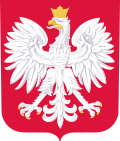| Coat of arms of Central Lithuania | |
|---|---|
 | |
| Armiger | Lucjan Żeligowski, Leader of Central Lithuania |
| Adopted | 12 October 1920 |
| Shield | red with silver (white) edge |
| Compartment | Silver (white) eagle and silver (white) Pahonia (a knight on a horse) |
| Use | Republic of Central Lithuania |
The coat of arms of the Republic of Central Lithuania, an unrecognized short-lived puppet republic of Poland, was established on 12 October 1920 and remained in use until 18 April 1922, when the state ceased to exist. [1]







